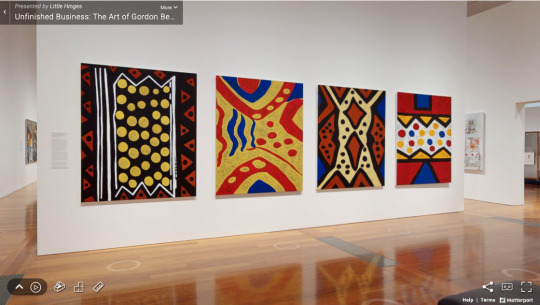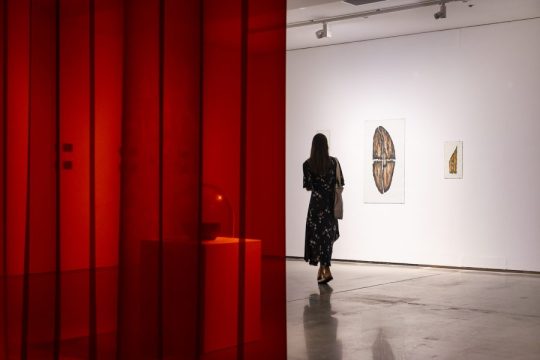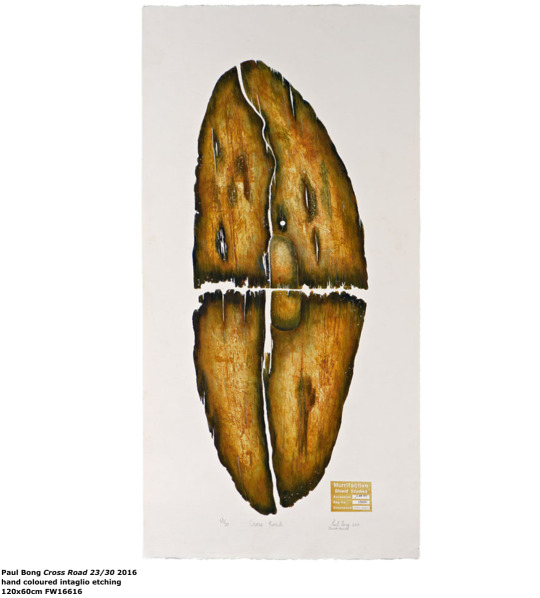Link
0 notes
Photo


Installation view: ‘Unfinished Business: The Art of Gordon Bennett’, Gallery of Modern Art, Brisbane.
In view, from left to right: Gordon Bennett’s Home décor (After M Preston) no. 25 (2013); Home décor (After M Preston) no. 3 (2010); Home décor (After M Preston) no. 11 (2010); and Home décor (After M Preston) no. 6 (2010).
Figure 1
0 notes
Photo

Installation view: ‘OCCURRENT AFFAIR’, University of Queensland Art Museum, Brisbane.
In view: Jennifer Herd, In Defence (2021). Image: Twitter/@UQArtMuseum.
Figure 2
0 notes
Photo



Installation view: ‘On Fire: Climate & Crisis’, Institute of Modern Art, Brisbane
In view, at right: Paul Bong, Cross Road (2016) and Dispersed Fragment (2016), Image: Carl Warner
—
Detail: Warraba Weatherall, To know and possess, 2021
Image: Institute of Modern Art
Figure 3
—
Paul Bong, Cross Road, 2016
hand-coloured intaglio etching, 120x60cm, Image: FireWorks Gallery
Figure 4
0 notes
Text
Annotated Bibliography
Ardill, Allan. 'Australian Sovereignty, Indigenous Standpoint Theory and Feminist Standpoint Theory: First Peoples' Sovereignties Matter. Griffith Law Review 22, 2 (2013): 315-343. https://doi.org/10.1080/10383441.2013.10854778.
Ardill highlights the importance of intersectionality and discusses the implications that colonial power structures have on critical literature. They emphasise the importance of standpoint, suggesting that failing to “bring First Peoples’ sovereignties to the fore” allows colonial knowledge to persist. This will be an important lens with which to view the narratives that are being curated for the contemporary art space.
Burns, Aileen, and Johan Lundh, eds., Gordon Bennett: be polite. (Brisbane, Australia: Institute of Modern Art, 2016).
Be Polite includes an essay by Julie Nagam entitled ‘Be polite … because the settlers might be listening and watching’. Therein, Nagam offers a critique of postcolonial theories and how Bennett analysed colonialism’s conceptual binaries in his work. Nagam discusses the alienating effect of the colonial gaze, calling for spaces where Indigenous people can “unbind from colonial relations on their own terms and from their own location” (174).
Butler, Rex, ed., What is appropriation? An anthology of writings on Australian art in the 1980s & 1990s. (Brisbane, Australia: Institute of Modern Art, 2004).
This anthology includes an interview transcript with Gordon Bennett where he discusses his practice and his thoughts on appropriation, especially in dialogue with other artists. This offers invaluable insight into Bennett’s practice and how he viewed referencing other artists (like Pollock) as being akin to making textual citations. This will help contextualise the dialogue he had with Margaret Preston’s oeuvre in his Home Décor series.
Giblin, John, Imma Ramos, and Nikki Grout. “Dismantling the master’s house.” Third Text 33, 4-5 (2019): 471-486. https://doi.org/10.1080/09528822.2019.1653065.
Giblin et al examine how institutions have been complicit with colonialism. In particular, they explore approaches to presenting objects in the museum space, and how experiences with colonialism may be “researched and exhibited through objects” (473) when looking to the future of museology. This text will help contextualise the research that underpins Warraba Weatherall’s practice.
McGonigle Leyh, Brianne. “Imperatives of the present: Black Lives Matter and the politics of memory and memorialization.” Netherlands Quarterly of Human Rights 38, 4(2020): 239–245. https://doi.org/10.1177/0924051920967541.
McGonigle Leyh explores the influence of the BLACKLIVESMATTER movement on revisiting approaches to memorialisation in contemporary communities. They consider the imperatives and dilemmas this poses for our time, and ongoing efforts to expose the racist foundations of our dominant historical narratives.
Kennedy, Rosanne, and Sulamith Graefenstein. “From the transnational to the intimate: multidirectional memory, the Holocaust and colonial violence in Australia and beyond.” International Journal of Politics, Culture, and Society 32 (2019): 403-422. https://doi.org/10.1007/s10767-019-09329-4.
Kennedy and Graefenstein explore the contentious history of public remembrance in Australia which has had significant implications on a shared sense of national identity. In the case of Holocaust remembrance, they identify that there has been a recent shift in focus from survivor memory to ongoing human rights violations, especially those affecting Indigenous Australians. They explore the notion of ‘multidirectional memory’ through the work of artist Judy Watson to consider the politics of location.
McLean, Ian, ed., How Aborigines invented the idea of contemporary art. (Sydney and Brisbane, Australia: Power Publications and Institute of Modern Art, 2011).
This book offers a multi-disciplinary chronicle of the complex relationship that Aboriginal art has had with the contemporary art scene since the 1980s. Through a number of writers - both Indigenous and non-Indigenous - it primarily deals with issues of the art world’s cultural imperialism and the appropriation that became prevalent through abstraction. This will assist in chronicling how shield designs have been appropriated and commercialised in contemporary art.
Pagliaro, Christina, ed., My Country, I still call Australia home: contemporary art from Black Australia. (Brisbane, Australia: Queensland Art Gallery, 2013).
This book contains an essay by Glenn Iseger-Pilkington who examines the aftermath of 2007’s Apology to Australia's Indigenous Peoples. Iseger-Pilkington poignantly states that “through the neglect or silencing of Indigenous narratives, Australia has incubated an environment of exclusion that inhibits both social and national reconciliation”. This supports the importance of critical museology to the narratives which are being validated in our art galleries.
Riley Walsh, Tim, ed., On fire: climate & crisis. (Brisbane, Australia: Institute of Modern Art, 2021).
This book is the publication for the exhibition of the same name. It sheds light on the exhibition rationale and objectives of Tim Riley Walsh as a non-Indigenous curator. One of the exhibition’s major themes included exploring the effect of ‘fossil-fueled capitalism’ (13) on Australia’s climate, which is emblematic of the enduring legacy of colonialism that also runs deep in our cultural institutions. The four accompanying essays offer an “analysis of the severity of our troubled contemporary moment” (14).
van Beek, Gosewijn. “The Rites of Things: A Critical View of Museums, Objects, and Metaphors.” Etnofoor - Fetishism 3, 1 (1990): 26-44. https://www.jstor.org/stable/25757708.
Van Beek provides a critical analysis of the Western practice of object collecting, which will help foreground the work of Weatherall and Bong. They consider the implications that this practice has had on cultural continuities, and how the violence associated with removing objects from their ‘living’ context contributes to the museological ‘death of the object’.
0 notes
Text
“Object-ivity”
Exploring how artists and curators are shaping the narrative of Indigenous Australian art through new representations of First Nations’ shields/shield designs
Focus: Through carefully curated displays and collections, our art galleries are memorialising our pasts, presents, and futures. The artworks inside our white cubes serve to validate social narratives about history and art. But with prevailingly Eurocentric spaces, the notion of ‘our’ is very much dependant on what narrative is being shared and by whom. Indigenous Australian shields have been the subject of numerous museum exhibits and critical discussions during the course of Australia’s colonial history. Some contemporary Indigenous Australian artists have been reclaiming their narratives in the museum space by (re)presenting shields in a fine art context. Gordon Bennett, Paul Bong, Jennifer Herd, and Warraba Weatherall have each explored shields and/or shield designs in their visual art practices: from Bennett’s dialogue on appropriation with Margaret Preston, to Weatherall’s critical engagement with archival processes. By (re)presenting shields through different mediums - such as painting, etching, installation, and pinholes on paper - the effect of the colonial gaze on the shield is slowly being minimized, with Indigenous cultural agency being brought back to the forefront.
Artists:
Gordon Bennett (1955-2014), born in Monto, Queensland, was a Brisbane-based visual artist. His work is currently featured at the Gallery of Modern Art’s retrospective exhibition ‘Unfinished Business’. Focus artworks: Home décor (After M Preston) series (Figure 1).
Jennifer Herd (b. 1951) is a Eumundi-based artist and professor with connections to the Mbar-barrum people. Herd is a current and founding member of the proppaNOW collective, who is currently exhibiting ‘OCCURRENT AFFAIR’ at the University of Queensland Art Museum. Focus artwork: In Defence (2021) (Figure 2).
Warraba Weatherall (b. 1987) is a Brisbane-based artist from the Kamilaroi Nation, who specialises in installation and street art. His work was included in the Institute of Modern Art’s exhibition On Fire: Climate and Crisis. Focus artwork: To know and possess (2021) (Figure 3).
Paul Bong (b. 1963) is a Cairns-based artist and a descendant of the Yidinji people. His work was also recently exhibited in ‘On Fire: Climate and Crisis’ at the Institute of Modern Art. Focus artwork: Cross Road (2016) (Figure 4).
Theme: This project aims to explore appropriation and critical museology/curation.
0 notes